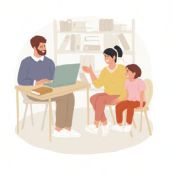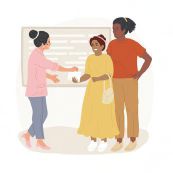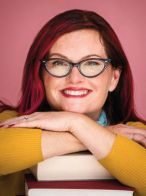VISION QUEST : WORKING TOWARDS A MEANINGFUL FUTURE
WHAT IS A VISION STATEMENT?
A vision statement is a long-term plan for your child's future. Your child's vision statement can involve your family, any members of your child's team, and anyone significant to your child's life. Ideally, a vision statement should involve the child to the fullest extent possible, and should grow and change as your child develops.
WHY PUT THE VISION STATEMENT IN WRITING?

While we may know in our minds how our children envision their future, or how we, as parents, envision that future. Putting the vision statement in writing allows us to incorporate it into all of the planning, and across all areas of our child's life. As our child grows, the vision statement will evolve. Having a record of the progressive vision statements can be a way to track our child's development, wants, needs, and supports over the years.
HOW TO APPROACH THE VISION STATEMENT?
Many parents find that evaluations and reports focus on the things a child cannot do. A vision statement is your opportunity to shift the conversation, by focusing on the things your child can do and building from there.
HOW DO YOU CREATE A VISION STATEMENT?

- Start with your child. Involve your child to the fullest extent possible. Know that the vision statement will evolve as your child grows.
- Think big picture. What is the vision for your child’s future, even beyond the next year, and even beyond graduation? How does your child move through life as an adult?
- Consider home, work, and play. Are you working towards independent living, employment, continued education, social and/or recreational outlets? Build from your child’s strengths and what they love. Think about how these will be built into their future.
- Build in supports and accommodations. What will your child need in order to achieve their desired level of independence? Will toilet training be a long-term goal? Will they need alternative means of communication? What will they need in order to set them up for success within the community and with peers?
- Aim high. Instead of all of the cant’s that we always hear, what is the optimum future that your child is working towards?
WHY DOES A VISION STATEMENT WORK?

First, it takes into account your child's autonomy, personal preferences, and support needs, and all of the things that your child will do. Second, it takes a big picture view, which allows you to ask how your planning for your child will serve this vision. This goes for all areas of planning, from the IEP, to the future care plan, to the ways that a service dog (or other supports) will be incorporated into daily living.
HOW DOES THIS MAKE ALL OF THE PAPERWORK EASIER?
In addition to being able to copy and paste the vision statement into documents, it gives us a baseline for our planning and conversations. For us this has looked like:
- More productive IEP meetings. In advance of our IEP meetings, we meet with our son's teacher and service providers to discuss: how his progress, goals, supports, and services build on where he is now, so that he may achieve this future vision.
- Therapy goals geared towards a big picture future. We work backwards from our future vision to create therapy goals, so that our child is working towards the things that will matter most to him in the big picture of his life.
- Future care plans that can be shared with family and friends who may be involved in our child's care. Familiarizing our friends and family with our son's care and future care plans becomes a conversation about empowering him for a meaningful future, when everyone is on board with the meaningful future that he will have.
- Advocacy for our son and others with an eye towards fostering self-determination. As we advocate for our son, and for other individuals with disabilities, we are both teaching him to advocate for himself, as well as advocating for the supports and services that will be necessary for him to lead a fully included, self-determined life.
Of the specific ways that our son's vision statement has shaped our planning, the renewed focus on his communication has become the most essential. Because of his vision statement, we considered and reconsidered how his communication is building towards an optimum future. We realized that his limited communication allowed him to communicate only with people familiar to him and who were familiar with his unique communication style (primarily gestures, with some vocalizations). He is a very social person who enjoys his time in the community, including greeting many new people, out in the world. When we built that into his future plan in earnest, we realized that it was time to expand his communication beyond his current levels. We committed to AAC (Alternative and Augmentative Communication, aka a communication device), despite our past frustrations with introducing it as a viable option. We tried many AAC programs, worked with several therapists, and brought the necessary training to everyone working with our son.
TThanks to the vision statement and our work to set our son up for success with that vision, he is now telling us things like “excited go school” and “tired go bed” and “watch different movie.” We look forward to a future where our son will craft a vision statement for himself, totally on his own. For now, “excited go school” seems like an excellent start. These days, I spend less time icing my hands and more time seeing my son develop into the rather amazing future self that we have all envisioned. •
ABOUT THE AUTHOR:

Kelley Coleman is the author of the book Everything No One Tells You About Parenting a Disabled Child: Your Guide to the Essential Systems, Services, and Supports. Her writing draws upon over a decade of advocating for parent caregivers and individuals with disabilities, including her own rather amazing son. kelleycoleman.com